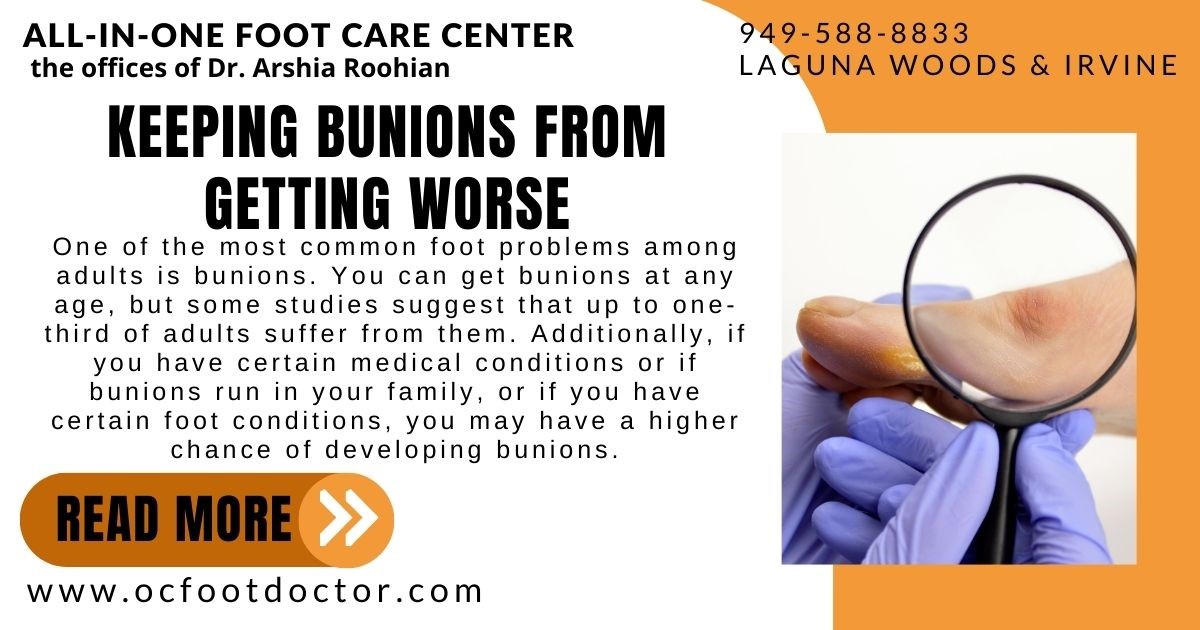Keeping Bunions From Getting Worse

One of the most common foot problems among adults is bunions. You can get bunions at any age, but some studies suggest that up to one-third of adults suffer from them. Additionally, if you have certain medical conditions or if bunions run in your family, or if you have certain foot conditions, you may have a higher chance of developing bunions.
What can you do to prevent bunions from forming? What can you do if you already have them to prevent them from getting worse? Find out below.
Here are 5 things you can do to prevent and manage bunions
1. Fit and size your shoes properly
You should wear the right kind of shoes to avoid bunions. When you have uneven pressure or friction on your toes, you are more likely to develop bunions.
- You should not feel pinching or rubbing when you slip your feet into a pair of shoes for the first time. You shouldn't have to break in a pair of shoes for months or weeks. Even after wearing a pair for a while, they may still not fit well. Your shoes should feel sturdy, but comfortable. Shop with instant comfort in mind when shopping.
- Your shoes should fit your feet properly and be the right length and width. Avoid tight, narrow, or pointy shoes, and choose styles that can accommodate your instep. When you slip your feet into shoes, your instep shouldn’t be a struggle. If you are looking for shoes with broad-toe boxes that won’t rub together, and soft soles that provide cushioning and support, look for shoes with broad-toe boxes.
- You may need an arch support insert in order to get the maximum level of comfort in your shoes. Some shoes come with built-in arch support, but you may need to add an arch support insert to get the maximum level of comfort.
What if you already have bunions? Can changing your shoes prevent them from getting worse?
It is impossible to reverse a bunion once it has started to form, but the right shoes can help relieve foot pain. They can also relieve pressure on your toe joint.
2. Don't wear high heels every day (or retire them altogether).
High heels put a lot of pressure on your toes, particularly your big toe joint. You should consider giving up heels in favor of supportive flats if you're not quite ready to go completely flat.
To prevent pressure, wear heels that are under two inches high. Or add wedges or block heels to your wardrobe since they distribute weight well.
3. Give your feet a rest
After standing for a while or moving around for quite a while, your feet deserve some rest and relaxation. Getting off your feet can help relieve some tension.
Give your feet some breathing room throughout the day by taking your shoes off. Even if you're wearing bunion-preventing shoes, they'll appreciate it.
4. Strengthen your feet by doing bunion stretches and exercises
Exercise can help strengthen and increase the flexibility in your feet, which can improve your foot health, relieve foot and ankle pain, relieve muscle soreness, and help you stay active.
Try these exercises for bunion prevention (or management)
Several sets of these exercises should be performed twice a day to improve the strength and flexibility of your feet:
- Pickups - Place 10 to 20 small objects on the floor. From a seated position, pick up each item using your toes and drop it into a container.
- For five minutes, curl your toes around a small towel and pull it toward you by bending your knees. Place the towel on the floor or in a chair within reach of your toes.
- Stretches – With your feet off the floor, curl your toes as far as possible while keeping your feet as pointed as possible. Repeat this exercise 10 times. You can also stretch your big toes by pulling them up with an exercise band. You can also push back through the toe as it is stretched to turn it into a resistance workout.
- Rolling - Place a can or a tennis ball under your foot and push down with it, rolling it along and around each foot for a couple of minutes.
5. Keep an eye on your feet
A bunion develops gradually, so watching for changes in your feet may help you catch subtle signs earlier. Pain, swelling, and redness in the big toe joint are some of the earliest signs of a bunion.
It's likely that things have advanced if you see a lump or bump on the side of your big toe, or if it's beginning to turn in toward the other toes.
The best thing you can do to relieve bunion pain is to schedule an appointment with a podiatrist. Podiatrists specialize in treating foot and ankle problems, and they can help you take the right next step.
Don't stop moving forward
A good pair of shoes is one of the best places to start when it comes to preventing bunions from getting worse or preventing them altogether. Your feet can be protected from painful foot conditions, such as bunions if you wear the right shoes.
You can contact our office at 949-588-8833, or visit our website at https://www.ocfootdoctor.com. Our offices are in Laguna Hills, Irvine, Mission Viejo, Aliso Viejo, Lake Forest, Foothill Ranch, and Costa Mesa.
📲 949-588-8833
🏢 24331 El Toro Rd, Suite 370 Laguna Woods CA 92637
🏢Irvine Medical Arts Building 113 Waterworks Way, Suite 250 Irvine, CA 92618
🌐 https://www.ocfootdoctor.com/
The information contained above is intended for general reference purposes only. It is not a substitute for professional medical advice or a medical exam. Always seek the advice of your physician or other qualified health professionals before starting any new treatment. Health information on this website MUST NOT be used to diagnose, treat, cure or prevent any disease without the supervision of your doctor.


